View in other NatureServe Network Field Guides
NatureServe
Montana
Utah
Wyoming
Idaho
Wisconsin
British Columbia
South Carolina
Yukon
California
New York
American Salmonfly - Pteronarcys dorsata
General Description
This species is not as famous as the Giant Salmonfly, but is still one of the largest species of all mayflies, stoneflies or caddisflies hatching on any cold water river, up to 2.5 inches long. In late-May thru early July, adults are hatching and providing trout fisherman with exciting dry-fly fishing on the surface or with large artificial nymphs. Adults are fairly weak fliers and are very conspicuous by their size and erratic flying over the river making them easy pickings for feeding trout and insectivorous birds. The American Salmonfly range in Montana has been reported in the Smith and Missouri River systems potentially being confused with the Giant Salmonfly.
Phenology
From late-May thru early July, adults are hatching and flying. June is the prime month for emergence
(Gaufin et al., 1972).
Diagnostic Characteristics
Salmonflies are easy to identify mostly by their tremendous size; often measuring nearly three inches in total length. As adults, they have a bright orange or red band behind the head and the underside of abdomen with broad wings containing dark veins
Species Range
Montana Range
Range Descriptions
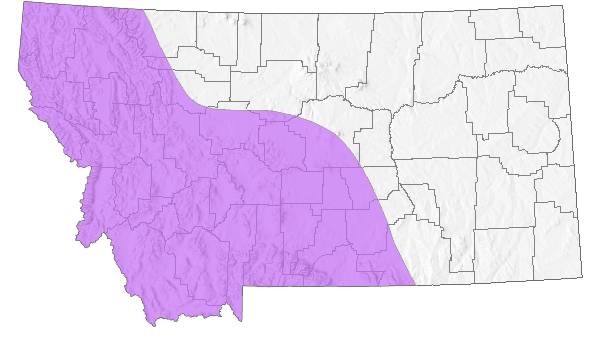
 Native
Native
Range Comments
This species is distributed throughout eastern North America, across Canada to Alaska (Stewart and Oswood, 2006). It is found from Labrador to southern Florida, throughout the Great Lakes, and several headwater rivers of the Platte and Missouri Rivers; with other populations farther north from Alberta and the Yukon.
Observations in Montana Natural Heritage Program Database
Number of Observations: 7
(Click on the following maps and charts to see full sized version)
Map Help and Descriptions
Relative Density
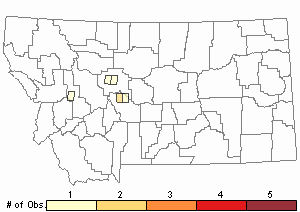
Recency
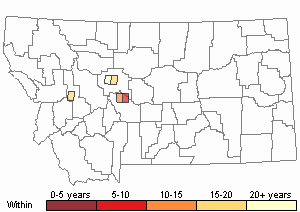
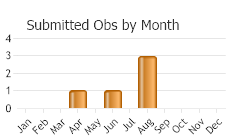
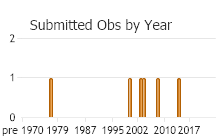
 (Observations spanning multiple months or years are excluded from time charts)
(Observations spanning multiple months or years are excluded from time charts)
Migration
This species is not known to migrate, but does preferentially fly upstream as adults.
Habitat
Salmonfly nymphs live on the bottom, crawling around on cobbles and feeding on large organic materials (leaves) in the spaces between rocks for three to sometimes four years. They require well-oxygenated water, so they thrive in swift, bouldery, riffly stretches of the river; narrow canyon reaches are ideal habitat.
Food Habits
Pteronarcys nymphs generally are considered shredders as a functional feeding group, and feed on large particulate organic and leaf materials that have collected in debris dams or behind boulders or logjams.
Ecology
Pteronarcys nymphs grow through many instars (12 - 20). The length of the life cycle is 3 to 4 years depending on elevation and degree days (water temperature + air)(Baumann et al. 1977). Mature nymphs migrate to shore in the spring and climb out of the water (mostly at night) before the final molt. Adults live for a few days to few weeks among shoreline vegetation or rocks and they feed little, if at all.
Reproductive Characteristics
From late-May thru early July, adults are hatching on adjacent riparian vegetation. Males attract mates by drumming rocks or wood, and mate while on the wing. Females lay the eggs directly on or above the water. The eggs separate and sink to the bottom to begin the next generation. Multiple cohorts may exist in any given river allowing a salmonfly hatch to occur every year, but some cohorts are stronger than others.
Stewardship Responsibility
Threats or Limiting Factors
The biggest threats to the salmonfly are attributable to the loss of habitat through siltation, sediment filling interstitial spaces in the cobbles or increasing water temperatures beyond the species thermal limits.
References
- Literature Cited AboveLegend:
 View Online Publication
View Online Publication Baumann, R.W, A.R. Gaufin, and R.F. Surdick. 1977. The stoneflies (Plecoptera) of the Rocky Mountains. American Entomological Society, Philadelphia.
Baumann, R.W, A.R. Gaufin, and R.F. Surdick. 1977. The stoneflies (Plecoptera) of the Rocky Mountains. American Entomological Society, Philadelphia. Gaufin, A.R., W.E. Ricker, M. Miner, P. Milam, and R.A. Hays. 1972. 'The Stoneflies (Plecoptera) of Montana'. Transactions of the American Entomological Society. 98 (1): 1-161.
Gaufin, A.R., W.E. Ricker, M. Miner, P. Milam, and R.A. Hays. 1972. 'The Stoneflies (Plecoptera) of Montana'. Transactions of the American Entomological Society. 98 (1): 1-161.
- Web Search Engines for Articles on "American Salmonfly"
- Additional Sources of Information Related to "Insects"





